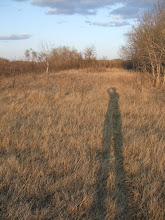Modified from a tutorial for padded wooden letters I saw at Aflutter: Fabric Letters How To. I didn't really want to make a padded letter (plus I have no idea where my glue gun is at the moment!) but I remembered reading somewhere that HeatnBond can be used to attach fabric to walls. If it works on walls, why not letters?
Materials
• Wooden letter
• Two colors of fabric
• HeatnBond Ultra Hold (I found this at Wal-Mart)
• Iron
• Fabric scissors
• Sharp knife or rotary cutter
• Tacky glue (clear drying). I used a scrap booking glue called Scotch Quick-Dry Adhesive.
• Card stock
• Ruler
• Cutting mat (if using a rotary cutter)
1) Prewash your fabric (may not be 100% necessary, but the HeatnBond instructions recommend it) and iron to remove any wrinkles.
2) Cut a piece of HeatnBond slightly larger than your letter. You want it large enough to wrap most of the way around the sides.
3) Iron your piece of HeatnBond to the wrong side of your main fabric. If you're using a directional fabric, make sure you apply the HeatnBond to the fabric fairly straight.
4) Cut your fabric out around the HeatnBond. It may be helpful to leave a little tab of unbonded fabric to make peeling the paper backing off easier.
5) Peel off the paper backing and position your fabric right side up on the right side of your letter. If your fabric is directional, this is the time to make sure you have the right side up and everything straight!
6) Iron your fabric onto the letter following the HeatnBond directions.
7) Trim off any fabric that will overlap past the edge of your letter. If you have long straight sides on your letter, fold them over and iron those down now.
8) Corners: To make your corners lie flat, fold your fabric over the corner, and run your finger over the overlapping fabric to make a finger crease. Cut out the little triangle of overlap with your scissors. Don't go all the way to the corner of the letter! Leave just a little bit there or there's a chance the wood might show through.
9) You may have to get creative with your cuts to make the fabric fold flat all the way around your letter.
10) Iron down any sides where your iron will reach. Otherwise, spread some tacky glue on the side of the letter and press your fabric down.
• At this point you may want to put a tiny dab of glue on all the corners to keep them from fraying.
11) Now for the trim. Cut out strips of card stock wide enough to cover the sides of your letter. I cut my strips just slightly narrower than my letter to account for the thickness that will be added by folding the fabric over.
12) Spread some tacky glue evenly over your strips, leaving the last couple of inches unglued for now, and attach them to the wrong side of your second fabric. Allow to dry, then cut your fabric. Leave enough fabric on all sides when gluing and cutting to fold around the paper strips later.
13) On the fully glued end of your trim stripe, cut the corners of the fabric off diagonally. Spread some glue on the end of the paper and glue the end of the fabric down.

14) At this point I fit my strips to the letter, folding at the bends (you may want to use your knife or cutter to lightly score the paper at the folds if your paper is particularly thick). I started with the end that I already folded over, then I trimmed the other end so the paper ended at a corner (and then trim the fabric so it's long enough to just cover the end of the paper). On outside corners I always let one end of the trim overlap the edge just a little so the next piece of trim would butt up against it nicely.
15) Spread glue on the edges of the paper strip and fold over the remaining fabric edges. It's helpful to dot a little glue on the corners of the fabric and sort of push them down a bit - neatens them up and keeps the fabric from fraying
16) Spread glue on the back of each strip (being careful not to get too much near the front edge, so nothing oozes out onto the front of the letter) and press into place along the edge of the letter, working from one end to the other. Make sure to press well around corners, and especially into the inside corners.
•Gaps: There were a few tiny gaps I wanted to fit more tightly, so I put some glue on the end of a pin and worked it in between the trim and the letter, then pressed for a few seconds.
17) Admire your finished letter!

































